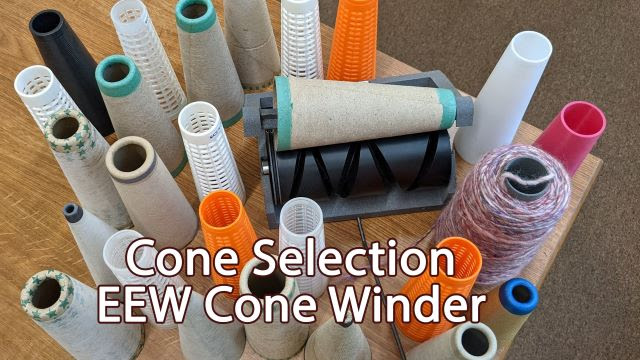EEW 6.0 Level Winding Flyer
One of the most commonly requested features for the EEW 6 is a system that automatically moves the yarn hooks on the flyer. A while ago the Level Wind Systems team, makers of the Autowind Flyers, reached out to me asking if I’d like them to make one for the EEW 6.0. To which I said, yes! In general I like it when other companies make accessories for the EEW community. I just don’t have enough time to do everything you folks want so when other businesses support this community is a win for those looking for the new options being offered. There are many businesses out there making 3D printed accessories for the EEW and I view this flyer as another option for you all to consider. I sent them some test units of the EEW 6.0 several months ago. They have finished their design and I’ve tested it. Overall, I’m impressed with the design. It is battery operated so the hooks move without adding any extra tension to the yarn which is an improvement over how the WooLee Winder works. This flyer does slow down the flyer speed by about 10% in my testing due to it’s heavier weight, but if you aren’t spinning at max speed this won’t have any impact on you. Some of the beta testers also noticed some vibrations at higher speeds, and the final design was changed to help reduce these in the final version. CraftmeHappy wrote an in depth review about an early prototype of their flyer and you can read about it in her blog here.
Just to be completely upfront about this, I’ve had little input into the design and this is not one of my products. While I currently make a little on each one sold because I sell them the metal spindles, making money is not my goal. My goal with this is to let you as members of the EEW community have lots of options. If you think this is a good fit for you then you can find the EEW 6.0 Autowinder here. If you get one I encourage you to post about it to the EEW Facebook or Ravelry group since I’m sure others will be waiting to see how it works for others.

Business Stuff
Handling business overhead is one of my least favorite tasks of running my own business. As my business has grown I’ve actually started paying people to handle my book keeping, taxes, and shipping. I still do all the day to day finances, but when I run into uncommon issues then I just let my bookkeeper or accountant handle them. That said I don’t really hate this work (I just like it less than everything else) and this is an area I’ve learned the most since leaving my previous engineering job and starting this business. This year my accountant said I’d save a lot of taxes going forward if I started filing taxes as an S Corporation. I won’t bore you with the details, but because of how tax rules are structured in the US I can pay a bunch of money to handle more complex tax filing, and then save even more money than I’ve spent on these things in lower taxes. It’s not at all the kind of efficient system I like, but it is the system I have. Changing to an S Corporation only makes sense for certain businesses once they reach a certain size to cover the overhead and I passed that size several years ago. I just keep putting off going to these more complex tax laws because I didn’t want to do all the extra work. I am setting things up now so my annual amount of time spent on these things won’t be much more than the old systems, but I will have to pay others to do extra work each year. Some examples of things I need to do is keeping accurate quarterly accounting records, filing new quarterly taxes, filing payroll, and filling out two full sets sets of taxes each year instead of just an extra form that gets appended to my personal taxes. This one time task of setting up all the changes to my business infrastructure for the new tax laws was a large portion of my work this month. Thankfully it is done now.
In addition to all the setup for S Corporations, I also found a new insurance company that gave me a significantly lower rate of insurance. I’m used to spending some time each month on business things, but I try to structure it so the amount of time is pretty low so I have more time to work on my products. This month was definitely an outlier in how much time I spent with these things. These are the required parts of running an efficient small business that most people don’t talk about because it’s kind of boring. Hope it wasn’t too boring to read about it here, but I don’t bring up this stuff often so I thought this month was a good time to pull back the curtain just a little at the less glamorous side of a small business. I think it’s good to know about these things since all these little reworks do end up getting factored into the final price of a product. I do my best to keep my overhead as low as possible to make my products more affordable for you.
Product Stock Update
Due to global shortages and increased demand several of my products are out of stock. Below are my best estimates on availability.
- EEW 6.0 – Early March 2022
- EEW Yarn Counter – Early March 2022
- EEW Nano 2 – May 2022 (preorders on Kickstarter in March)
Happy spinning!
– Maurice Ribble
(Inventor of the Electric Eel Wheel)
www.dreamingrobots.com
EEW Facebook Group
EEW Ravelry Group
EEW Youtube Channel
EEW Instagram Account
EEW Discord Server




















